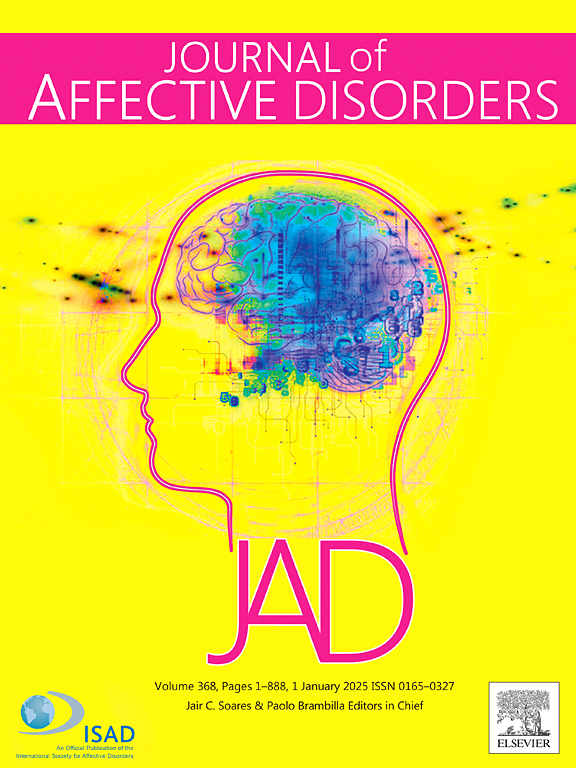学龄儿童孤独感及其影响因素的潜类分析:一项横断面调查
IF 4.9
2区 医学
Q1 CLINICAL NEUROLOGY
引用次数: 0
摘要
背景:由于学龄儿童的脆弱性,儿童孤独已成为一个日益普遍的公共卫生问题。本研究旨在根据学龄儿童表现出的孤独症状来识别他们的潜在类别,并探讨其影响因素:方法:于 2023 年 3 月至 6 月在中国汕头市进行了一项横断面研究。通过问卷调查收集了儿童的人口统计学特征、简短症状问卷(ASQ)、儿童孤独感量表(CLS)、感知社会支持量表(PSSS)和儿童希望量表(CHS)。根据学龄儿童的孤独症状进行了潜类分析(LCA),并通过卡方检验、方差分析、套索回归和多项式逻辑回归分析探讨了班级特征和影响因素:共有 2514 名学龄儿童参加了研究。结果:总共有 2514 名学龄儿童参与了研究,其中发现了四个不同的潜在类别,即低度孤独感组、边缘孤独感组、中度孤独感组和高度孤独感组,每个类别的比例分别为 37.0%、40.4%、10.3% 和 12.3%。与低度孤独感组相比,其他各组孤独感症状的影响因素依次为年级、学习成绩、父亲受教育程度、受欺负经历、受人身攻击经历、父母辅导功课情况、独生子女状况、朋友数量、与朋友的关系、感受到父母的尊重、感知到的社会支持以及希望(均为 P 局限性:研究的横断面设计、有限的样本和地区以及自我报告方法可能会影响研究结果的可靠性和普遍性:LCA 可以根据不同学龄儿童的孤独症状对其进行分类,为解决孤独问题提供了一个新的视角。本文章由计算机程序翻译,如有差异,请以英文原文为准。
Latent class analysis of loneliness and the influencing factors among school-age children: A cross-sectional survey
Background
Children's loneliness has become an increasingly pervasive issue of public health due to the vulnerability of school-aged children. This study aims to identify latent classes of school-age children based on their exhibited symptoms of loneliness and explore the influencing factors.
Methods
A cross-sectional study was conducted from March to June 2023 in Shantou, China. Demographic characteristics, Abbreviated Symptom Questionnaire (ASQ), Children's Loneliness Scale (CLS), Perceived social support Scale (PSSS), and Children's Hope Scale (CHS) were collected by questionnaires. Latent class analysis (LCA) was performed based on loneliness symptoms among school-age children, with class characteristics and influencing factors explored through chi-square tests, analysis of variance, lasso regression, and multinomial logistic regression analyses.
Results
A total of 2514 school-age children were enrolled. Four diverse latent classes were identified, namely, the low loneliness group, the borderline loneliness group, the moderate loneliness group, and the high loneliness group, with 37.0 %, 40.4 %, 10.3 % and 12.3 % in each class, respectively. Compared with the low loneliness group, the factors influencing loneliness symptoms in other groups were grade, academic performance, father's education level, experience of being bullied, experience of being physical attacked, homework help from parents, one-child status, number of friends, relationship with friends, feeling respect from parents, perceived social support, as well as hope (all P < 0.05).
Limitations
The study's cross-sectional design, limited sample and area, and self-reporting method may affect the findings' reliability and generalizability.
Conclusions
LCA can categorize different school-age children according to their loneliness symptoms, offering a new perspective of addressing loneliness issues.
求助全文
通过发布文献求助,成功后即可免费获取论文全文。
去求助
来源期刊

Journal of affective disorders
医学-精神病学
CiteScore
10.90
自引率
6.10%
发文量
1319
审稿时长
9.3 weeks
期刊介绍:
The Journal of Affective Disorders publishes papers concerned with affective disorders in the widest sense: depression, mania, mood spectrum, emotions and personality, anxiety and stress. It is interdisciplinary and aims to bring together different approaches for a diverse readership. Top quality papers will be accepted dealing with any aspect of affective disorders, including neuroimaging, cognitive neurosciences, genetics, molecular biology, experimental and clinical neurosciences, pharmacology, neuroimmunoendocrinology, intervention and treatment trials.
 求助内容:
求助内容: 应助结果提醒方式:
应助结果提醒方式:


